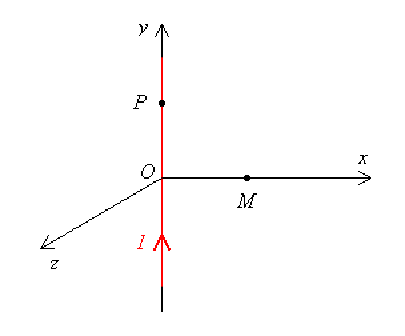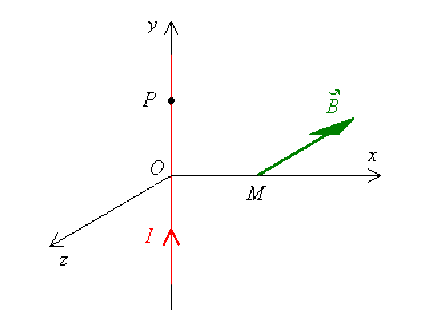Fil rectiligne de longueur infinie en coordonnées cartésiennes
Partie
Question
Un fil rectiligne de longueur infinie est parcouru par un courant \(I\).
Nous travaillons dans la base \(\mathcal{B} = (\vec{e_x}, \vec{e_y}, \vec{e_z})\).
Soient \(M\) le point de coordonnées \((x, 0, 0)\) et \(P\) le point de coordonnées \((0, y, 0)\) associé à l'élément de courant \(I . \vec{\mathrm{d}l}\).

Exprimer le champ magnétostatique élémentaire \(\vec{\mathrm{d}B}(M)\) en appliquant la loi de Biot et Savart.
En déduire le champ magnétostatique \(\vec B(M)\) sachant que \(\displaystyle{ \int_{-\infty}^{+\infty}\frac{x}{\left(x^2+y^2\right)^{3/2}}\mathrm{d}y = \frac{2}{x} }\)
Aide simple
Exprimer \(\vec{\mathrm{d} l}(P)\) et \(\vec{PM}\) dans la base \(\mathcal{B} = (\vec{e_x}, \vec{e_y}, \vec{e_z})\) et calculer le produit vectoriel.
Rappel de cours
Le produit scalaire :
\(\vec A.\vec B=\left(\begin{array}{c} A_1\\A_2\\A_3\end{array} \right)_{\mathcal{B}} . \left(\begin{array}{c} B_1\\B_2\\B_3\end{array} \right)_{\mathcal{B}} =A_1B_1+A_2B_2+A_3B_3\)
Le produit vectoriel :
\(\vec A\wedge\vec B=\left(\begin{array}{c} A_1\\A_2\\A_3\end{array} \right)_{\mathcal{B}} \wedge\left(\begin{array}{c} B_1\\B_2\\B_3\end{array} \right)_{\mathcal{B}} =\left(\begin{array}{c} A_2B_3-A_3B_2\\A_3B_1-A_1B_3\\A_1B_2-A_2B_1\end{array} \right)_{\mathcal{B}}\)
Les opérateurs vectoriels :
Système de repérage cartésien \(\mathcal{B}_{\mathrm{cart.}}(\vec{e_x}, \vec{e_y}, \vec{e_z})\)
gradient : \(\vec{\mathrm{grad}}U\) | divergence : \(\mathrm{div}\vec A\) | rotationnel : \(\vec{\mathrm{rot}}\vec A\) |
\(\left(\begin{array}{c} \displaystyle{ \frac{\partial U}{\partial x} } \\ \displaystyle{ \frac{\partial U}{\partial y} } \\ \displaystyle{ \frac{\partial U}{\partial z} } \end{array} \right)_{\mathcal{B}_{\mathrm{cart.}}}\) | \(\displaystyle{ \frac{\partial A_x}{\partial x}+\frac{\partial A_y}{\partial y}+\frac{\partial A_z}{\partial z} }\) | \(\left(\begin{array}{c} \displaystyle{ \frac{\partial A_z}{\partial y}-\frac{\partial A_y}{\partial z} } \\ \displaystyle{ \frac{\partial A_x}{\partial z}-\frac{\partial A_z}{\partial x} } \\ \displaystyle{ \frac{\partial A_y}{\partial x}-\frac{\partial A_x}{\partial y} }\end{array} \right)_{\mathcal{B}_{\mathrm{cart.}}}\) |
Système de repérage cylindrique \(\mathcal B_{\mathrm{cyl.}}(\vec{e_r},\vec{e_{\theta}},\vec{e_z})\)
gradient : \(\vec{\mathrm{grad}}U\) | divergence : \(\mathrm{div}\vec A\) | rotationnel : \(\vec{\mathrm{rot}}\vec A\) |
\(\left(\begin{array}{c} \displaystyle{ \frac{\partial U}{\partial r} } \\ \displaystyle{ \frac{1}{r} \frac{\partial U}{\partial \theta} }\\ \displaystyle{ \frac{\partial U}{\partial z} } \end{array} \right)_{\mathcal{B}_{\mathrm{cyl.}}}\) | \(\displaystyle{ \frac{1}{r} \frac{\partial (r . A_r) }{\partial r} + \frac{1}{r} \frac{\partial A_{\theta}}{\partial \theta}+\frac{\partial A_z}{\partial z} }\) | \(\left(\begin{array}{c} \displaystyle{ \frac{1}{r} \frac{\partial A_z}{\partial \theta}-\frac{\partial A_ \theta}{\partial z} } \\ \displaystyle{ \frac{\partial A_r}{\partial z}-\frac{\partial A_z}{\partial r} } \\ \displaystyle{ \frac{1}{r} \left( \frac{\partial (r. A_{\theta})}{\partial r}-\frac{\partial A_r}{\partial \theta} \right)} \end{array} \right)_{\mathcal{B}_{\mathrm{cyl.}}}\) |
Nom de l'outil | Comment s'énonce-t-il ? | Quand l'utiliser ? |
Théorème d'Ampère | \(\displaystyle{ \oint_{\mathcal C}\vec B.\vec{\mathrm{d}l}=\mu_0\sum I }\) | Pour calculer \(\vec B\) si la géométrie du problème permet un calcul simple de la circulation de \(\vec B\). |
Loi de Biot et Savart | \(\displaystyle{ \vec B(M)=\frac{\mu_0}{4\pi}\int_{\mathcal D}\vec{\mathrm{d} \mathcal C}(P)\wedge\frac{\vec{PM}}{PM^3} }\) | Pour calculer \(\vec B\) si la géométrie de la distribution ne permet pas une application simple du théorème d'Ampère. |
Relation champ magnétostatique/ potentiel vecteur | \(\vec{B}(M)=\vec{\mathrm{rot}}\vec A(M)\) | Pour calculer \(\vec B\) si \(\vec A\) est connu. |
Définition de la force de Laplace | \(\vec{F_m}=\displaystyle{ \int_{\mathcal D}\vec{\mathrm{d} \mathcal C}(P)\wedge\vec B_{\mathrm{ext}}(P) }\) | Pour calculer la force qui s'exerce sur une distribution \(\mathcal D\) soumise à un champ magnétostatique extérieur \(\vec B_{\mathrm{ext}}\) |
Théorème de Maxwell | \(W_{2\leftarrow1}=I . \Phi_c\) | Pour calculer directement le torseur des forces qui agissent sur un circuit. |
Définition du potentiel vecteur | \(\displaystyle{ \vec A(M)=\int_{\mathcal D}\frac{\mu_0}{4\pi}\frac{\vec{\mathrm{d}\mathcal C}(P)}{PM} }\) | Pour calculer \(\vec A\) si la distribution a un haut degré de symétrie. |
Solution détaillée
Déterminons \(\vec{\mathrm{d}B}(M)\) en utilisant la loi de Biot et Savart :
\(\displaystyle{ \vec{\mathrm{d}B}(M)=\frac{\mu_0}{4\pi}\left(I\vec{\mathrm{d}l}(P)\wedge\frac{\vec{PM}}{PM^3}\right) }\)
Dans la base \(\mathcal B=(\vec{e_x},\vec{e_y},\vec{e_z})\), les coordonnées des différents vecteurs sont :
\(I\vec{\mathrm{d}l}(P)=I . \mathrm{d}\vec{OP}=I . \mathrm{d}\left(\begin{array}{c}0\\y\\0\end{array}\right)=\left(\begin{array}{c}0\\I . \mathrm{d}y\\0\end{array}\right)\quad \vec{PM}=\left(\begin{array}{c}x\\-y\\0\end{array}\right) \mathrm{ }\) et \(\mathrm{ } PM^3 = \left(x^2+y^2 \right)^{3/2}\)
Calculons maintenant \(\displaystyle{ \vec{\mathrm{d}B}(M)=\frac{\mu_0}{4\pi}\left(I\vec{\mathrm{d}l}(P)\wedge\frac{\vec{PM}}{PM^3}\right) }\) :
\(\vec{\mathrm{d}B}(M)=\displaystyle{\frac{\mu_0}{4\pi}\frac{1}{\left(x^2+y^2\right)^{3/2}}\left(\begin{array}{c}0\\I . \mathrm{d}y\\0\end{array}\right)\wedge\left(\begin{array}{c}x\\-y\\0\end{array}\right)=\frac{\mu_0}{4\pi}\frac{1}{\left(x^2+y^2\right)^{3/2}}\left(\begin{array}{c}0\\0\\-I x . \mathrm{d}y\end{array}\right) }\)
d'où : \(\displaystyle{ \vec{\mathrm{d}B}(M)=-\frac{\mu_0I}{4\pi}\frac{x}{\left(x^2+y^2\right)^{3/2}}\mathrm{d}y.\vec{e_z} }\)
Le champ magnétostatique peut alors être déterminé en sommant les champs élémentaires \(\vec{\mathrm{d}B}(M)\) sur l'ensemble du fil (\(y\) variant de \(-\infty\) à \(+\infty\) le long du fil) :
\(\displaystyle{ \vec B(M)=-\frac{\mu_0I}{4\pi}\int_{-\infty}^{+\infty}\frac{x}{\left(x^2+y^2\right)^{3/2}}\mathrm{d}y.\vec{e_z}=-\frac{\mu_0I}{4\pi}\frac{2}{x}.\vec{e_z}=-\frac{\mu_0I}{2\pi x}.\vec{e_z} }\)

Remarque :
On peut comparer le résultat obtenu avec celui du cours dans la base \(\mathcal{B} = (\vec{e_{\rho}}, \vec{e_{\phi}}, \vec{e_z})\)